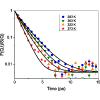当前位置:
X-MOL 学术
›
Phys. Rev. B
›
论文详情
Our official English website, www.x-mol.net, welcomes your
feedback! (Note: you will need to create a separate account there.)
Slow structural relaxation process facilitates solidification in liquid gallium
Physical Review B ( IF 3.2 ) Pub Date : 2020-01-23 , DOI: 10.1103/physrevb.101.014207 F. Demmel
Physical Review B ( IF 3.2 ) Pub Date : 2020-01-23 , DOI: 10.1103/physrevb.101.014207 F. Demmel

|
The structural relaxation dynamics in liquid and 20 K undercooled gallium has been studied by neutron spectroscopy. The intermediate scattering function at the structure factor maximum was measured over a wide temperature range up to twice the melting temperature. A stretched exponential decay was observed near the melting point which transforms to an exponential decay above . The structural relaxation process beyond 3 ps can be described as a further slow exponential decay. Mode coupling theory is able to calculate the decay rate of this slow structural relaxation, which agrees well with the measurement. This additional structural relaxation, observed in the collective particle motions on next-neighbor distances, can be understood as a slow cage relaxation process, setting in around 370 K and indicating the slowing down of dynamics towards solidification. This process might be the microscopic origin for observed changes in the collective particle dynamics of liquid gallium with decreasing temperature. Liquid aluminium, lead, and rubidium demonstrate a similar behavior, which suggests a universal crossover in dynamics of the equilibrium liquid metal state.
中文翻译:

缓慢的结构弛豫过程有助于液态镓中的凝固
通过中子光谱研究了液态和20 K过冷镓中的结构弛豫动力学。在高达熔化温度两倍的较宽温度范围内测量了最大结构因子时的中间散射函数。在熔点附近观察到拉伸的指数衰减,其转变为高于熔点的指数衰减。。超过3 ps的结构弛豫过程可以描述为进一步缓慢的指数衰减。模耦合理论能够计算出这种缓慢结构松弛的衰减率,这与测量结果非常吻合。在邻近的距离上的集体粒子运动中观察到的这种额外的结构弛豫可以理解为缓慢的笼形弛豫过程,大约在370 K左右,表明动力学趋于凝固。这个过程可能是观察到的液态镓的集体粒子动力学随温度降低而变化的微观起源。液态铝,铅和rub表现出相似的行为,这表明平衡液态金属态的动力学普遍发生交叉。
更新日期:2020-01-23
中文翻译:

缓慢的结构弛豫过程有助于液态镓中的凝固
通过中子光谱研究了液态和20 K过冷镓中的结构弛豫动力学。在高达熔化温度两倍的较宽温度范围内测量了最大结构因子时的中间散射函数。在熔点附近观察到拉伸的指数衰减,其转变为高于熔点的指数衰减。。超过3 ps的结构弛豫过程可以描述为进一步缓慢的指数衰减。模耦合理论能够计算出这种缓慢结构松弛的衰减率,这与测量结果非常吻合。在邻近的距离上的集体粒子运动中观察到的这种额外的结构弛豫可以理解为缓慢的笼形弛豫过程,大约在370 K左右,表明动力学趋于凝固。这个过程可能是观察到的液态镓的集体粒子动力学随温度降低而变化的微观起源。液态铝,铅和rub表现出相似的行为,这表明平衡液态金属态的动力学普遍发生交叉。











































 京公网安备 11010802027423号
京公网安备 11010802027423号